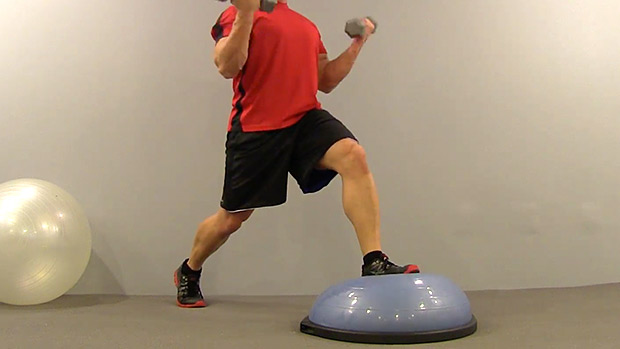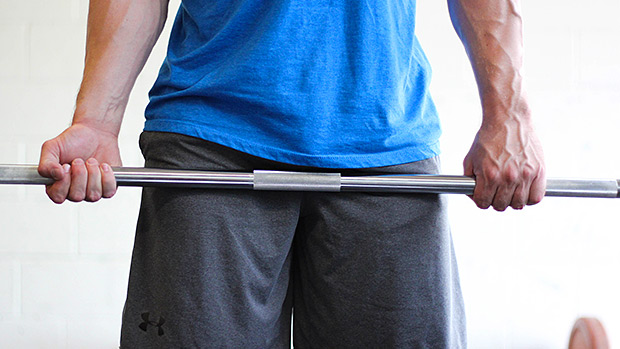Strength Basics
Getting stronger is pretty simple when you break it down. If you're doing basic, whole-body compound movements like squatting, hinging (deadlifting etc.), pushing, pulling, and carrying heavy objects, then you're on the right track.
Unfortunately, there are a lot of people out there selling gimmicky programs and exercises that will make you anything but strong. To help you reach your goals and make sure you're not wasting your time on someone else's BS, don't make these mistakes.
When it comes to compound movements, simple is generally better. Holding a kettlebell by the handle overhead with one arm as you do a horizontal banded press with the other arm while standing on one foot on an unstable surface is not "achieving core activation, balance, and coordination." It's just making you look like a douchebag.
Being a functionally strong human being requires that your muscles work together to lift or resist an external load. If you're trying to do too many things at once, your body won't be able to recruit the necessary motor neurons to get your muscles to synergistically fire.
If your body can't get an appreciable amount of muscle involved to lift or resist an external load, then you won't get strong. It really is as simple as that.
Picking simple compound movements like the back squat, trap-bar deadlift, pull-up, and press – and doing them with a lot of weight – will make you infinitely stronger than doing combined exercises such as lunging while doing curls.

Trying to do multiple movements in one exercise is like a baseball pitcher thinking he needs to take up juggling in order to throw the ball harder. Confusing your body arbitrarily doesn't mean you're getting any closer to achieving your goal.
If you're a natural lifter, you need to start seeing your body as one unit instead of a lot of individual parts. If you're the person who does chest/triceps on Mondays, legs on Tuesdays, and back/biceps on Fridays, you're probably not seeing the results you'd like see.
It's not from a lack of effort, but from a lack of good strategy and programming. You're in a weird situation where you're both doing too much work and not nearly enough work at the same time.
Performing ten different chest exercises for 3-5 sets each on Monday is too much volume that day (if you're not juicing). At the same time, you're doing nothing with the chest the rest of the week, so it's not being worked frequently enough.
If you're on this type of program, your progress is going to stall out quickly.
Instead, try to do whole-body lifts three times per week.
Not sure where to start? Use the 3 day per week template below. This program will have you doing five exercises per day and will allow you to train your body frequently enough to get some results. You'll squat, hinge, lunge, push, pull, and carry heavy objects – all the stuff that makes a person strong.
Day 1
- A1 Back Squat: 5x5
- A2 Dumbbell Bench Press: 5x8
- A3 1-Arm Dumbbell Row: 5x10
- B1 Farmer's Walk: 3x20 yards
- B2 Pallof Press: 3x10 each side
Day 2
- A1 Standing Barbell Strict Press: 5x5
- A2 Pull-Up: 5x8
- A3 Step-Back Lunges: 5x8 each
- B1 Waiter's Carry: 3x20 yards
- B2 Hanging Knee Raises: 3x10
Day 3
- A1 Trap Bar Deadlift: 3x5
- A2 Incline Dumbbell Bench Press: 5x8
- A3 Chest-Supported Row: 5x10
- B1 Suitcase Carry (a farmer's walk carrying weight only on one side): 3x20 yards
- B2 Cable Chop: 3x10 each side
When you're just starting out, using a program based off a percentage of your one rep max is a mistake.
Asking strong guys what program they're doing can help you with your goals, but only if you have a similar training background. If you're a beginner and the person you're asking recommends a program based off a percentage of your 1RM, you should probably find a new program.
New lifters shouldn't be basing anything off of a one rep max because they don't have the experience to perform a true 1RM. The first couple of weeks when you begin a weight training program are some of the most fun weeks you'll ever have. You'll make tremendous progress because you're learning to recruit motor neurons to carry out new movement patterns.
The strength gains you make for the first 4-8 weeks will come in leaps and bounds, so you shouldn't be limiting yourself by basing your program off of the perceived 1RM you could do on day one.
Instead, try to work up to a weight that causes you technical failure: go as heavy as you can until your technique starts to break down. Do this for approximately 6 months to a year as you vary your exercises and rep ranges. Adopt a program based on percentages AFTER you've become proficient at your lifts.





